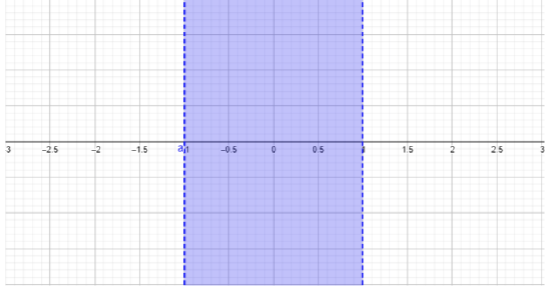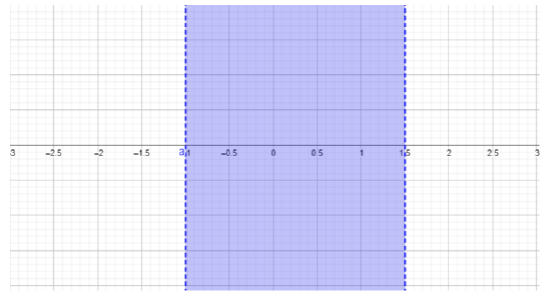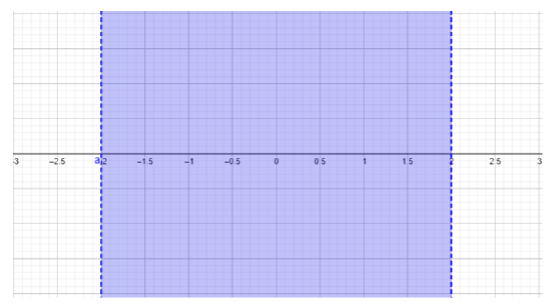10.3: Rational Inequalities
- Page ID
- 45213
Solving rational inequalities involves finding the zeroes of the numerator and denominator, then using these values to investigate solution set regions on the number line.
Solve the inequalities and write the solution sets in interval notation:
- \(\dfrac{x − 1}{x + 1} ≥ 0\)
- \(\dfrac{2x − 3}{x + 1} ≤ 0\)
- \(\dfrac{x + 2}{x − 2} ≥ 0\)
Solution
- \(\begin{array} &&\dfrac{x − 1}{x + 1} ≥ 0 &\text{Example problem} \\ &\dfrac{x − 1}{x + 1} ≥ 0 &\text{The quotient must be greater than or equal to \(0\).} \\ &x − 1 = 0,\; x = 1 &\text{Find the zeroes of the numerator} \\ &x + 1 = 0, x = \;−1 &\text{Find the zeroes of the denominator} \end{array}\)

\(\begin{array} &&\text{For } x < −1, \text{ choose } x = −2. \;\;\dfrac{−2 − 1}{−2 + 1} = \dfrac{−3}{−1} = 3 ≥ 0 \\ &\text{Replacing \(-2\) for \(x\) results in the answer \(3\), which is greater than or equal to \(0\). This region \(x < −1\) is included in the solution set.} \\[0.25in] &\text{For } −1 < x < 1, \text{ choose } x = 0.\;\; \dfrac{0 − 1}{0 + 1} = \dfrac{−1}{1} = −1 < 0 \\ &\text{Replacing \(0\) for \(x\) results in the answer \(-1\), which is less than \(0\), not fulfilling the given inequality in the problem.} \\ &\text{This region \(−1 < x < 1\) is excluded from the solution set.} \\[0.25in] &\text{For } x > 1, \text{ choose } x = 2.\;\; \dfrac{2 − 1}{2 + 1} = \dfrac{1}{3} ≥ 0 \\ &\text{Replacing \(2\) for \(x\) results in the answer \(\dfrac{1}{3}\), which is greater than or equal to \(0\). This region \(x > 1\) is included in the solution set.} \\[0.25in] &(−∞, −1) ∪ (1, ∞) \\ &\text{Final answer written in interval notation (see section on Interval Notation for more details).} \end{array}\)
- \(\begin{array} &&\dfrac{2x − 3}{x + 1} ≤ 0 &\text{Example problem} \\ &\dfrac{2x − 3}{x + 1} ≤ 0 &\text{The quotient must be less than or equal to \(0\).} \\ &2x − 3 = 0,\; x = 1.5 &\text{Find the zeroes of the numerator} \\ &x + 1 = 0,\; x = −1 &\text{Find the zeroes of the denominator} \end{array}\)

\(\begin{array} &&\text{For } x < −1, \text{ choose } x = −2. \;\; \dfrac{2(−2) − 3}{−2 − 1} = \dfrac{−7}{−3} = \dfrac{7}{3} ≥ 0 \\ &\text{Replacing \(-2\) for \(x\) results in the answer \(\dfrac{7}{3}\), which is greater than \(0\), not fulfilling the given inequality in the problem.} \\ &\text{This region \(x < −1\) is excluded from the solution set.} \\[0.25in] &\text{For } −1 < x < 1.5, \text{ choose } x = 0. \;\; \dfrac{2(0) − 3}{0 − 1} = \dfrac{−3}{−1} = 3 ≥ 0 \\ &\text{Replacing \(0\) for \(x\) results in the answer \(3\), which is greater than or equal to \(0\), which is not what the problem is asking for.} \\ &\text{This region \(−1 < x < 1.5\) is excluded in the solution set.} \\[0.25in] &\text{For } x > 1, \text{ choose } x = 2. \;\; \dfrac{2(2) − 3}{2 − 1 }= \dfrac{1}{1} = 1 ≥ 0 \\ &\text{Replacing \(2\) for \(x\) results in the answer \(1\), which is greater than or equal to \(0\). This region \(x > 1\) is excluded in the solution set.} \\[0.25in] &∅ \\ &\text{This problem has no solution. \(\dfrac{2x − 3}{x + 1}\) will never be less than or equal to \(0\).} \end{array}\)
- \(\begin{array} &&\dfrac{x + 2}{x − 2} ≥ 0 &\text{Example problem} \\ &\dfrac{x + 2}{x − 2} ≥ 0 &\text{The quotient must be greater than or equal to \(0\).} \\ &x + 2 = 0, \;\;x = −2 &\text{Find the zeroes of the numerator} \\ &x − 2 = 0,\;\; x = 2 &\text{Find the zeroes of the denominator} \end{array}\)

\(\begin{array} &&\text{For } x < −2, \text{ choose } x = −3. \dfrac{−3 + 2}{−3 − 2} = \dfrac{−1}{−5} = \dfrac{1}{5} ≥ 0 \\ &\text{Replacing \(-3\) for \(x\) results in the answer \(\dfrac{1}{5}\), which is greater than or equal to \(0\). This region \(x < −2\) is included in the solution set.} \\[0.25in] &\text{For } −2 < x < 2, \text{ choose } x = 0. \;\; \dfrac{0 + 2}{0 − 2} = \dfrac{2}{−2} = −1 < 0 \\ &\text{Replacing \(0\) for \(x\) results in the answer \(-1\), which is less than \(0\), not fulfilling the given inequality in the problem.} \\ &\text{This region \(−2 < x < 2\) is not included in the solution set.} \\[0.25in] &\text{For } x > 2, \text{ choose } x = 3. \;\; \dfrac{3 + 2}{3 − 2} = \dfrac{5}{1} = 5 ≥ 0 \\ &\text{Replacing \(3\) for \(x\) results in the answer \(5\), which is greater than or equal to \(0\). This region \(x > 2\) is included in the solution set.} \\[0.25in] &(−∞, −2) ∪ (2, ∞) \\ &\text{Final answer written in interval notation (see section on Interval Notation for more details).} \end{array}\)
- \(\dfrac{x + 3}{x − 2} ≥ 0\)
- \(\dfrac{x − 2}{x − 1} ≤ 0\)
- \(\dfrac{2x − 1}{x + 2} ≤ 0\)
- \(\dfrac{2x − 3}{x + 1} ≥ 0\)


